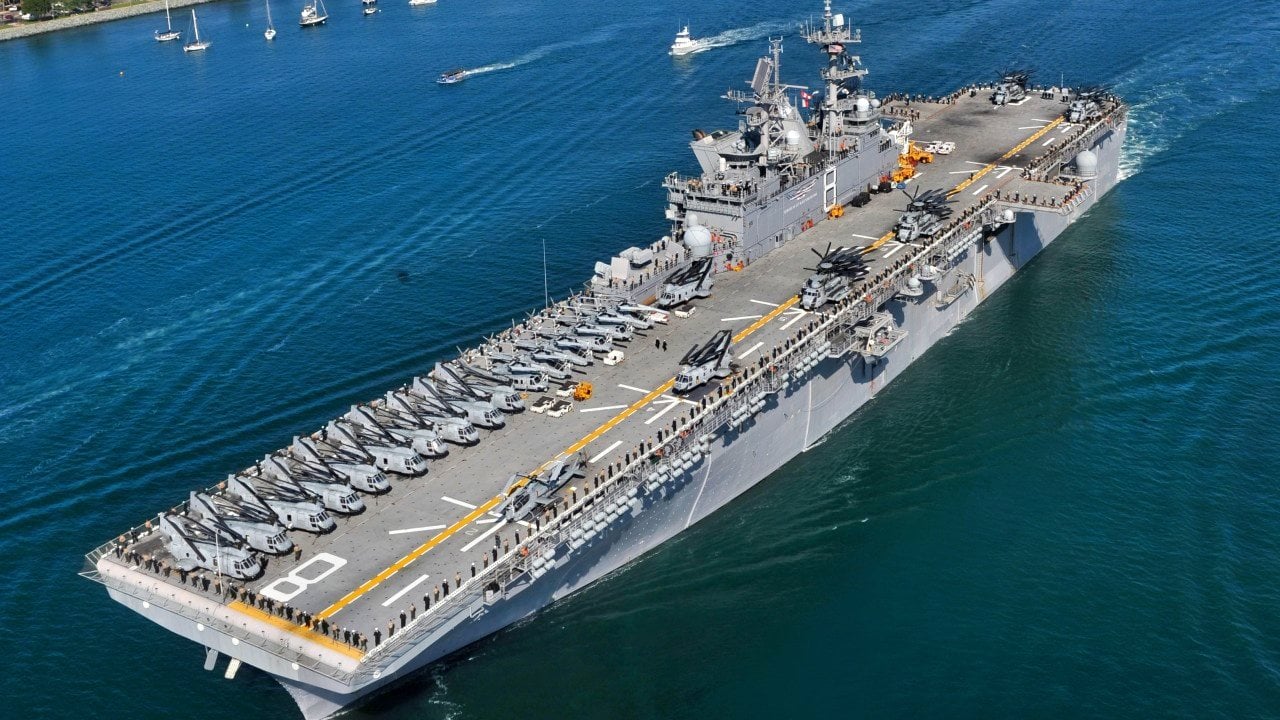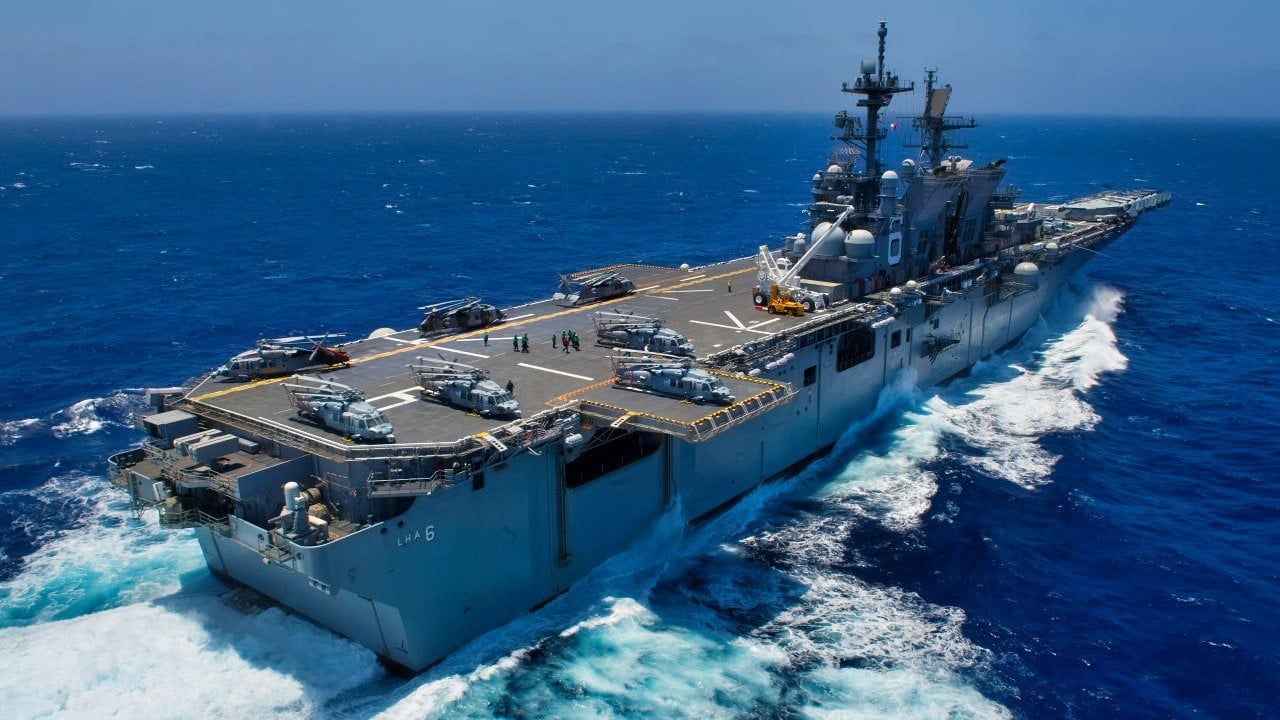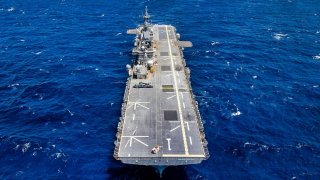U.S. Navy Assault Ships: America's Mini Aircraft Carriers?
The unique capabilities of the Navy’s amphibious assault ships would undoubtedly come in handy if a conflict with China were to erupt in the near future.
Summary: The resurgence of amphibious operations in the U.S. Navy highlights a strategic shift as tensions rise with China, especially in the South China Sea. Amphibious assault ships, specifically the Landing Helicopter Dock (LHD) and Landing Helicopter Assault (LHA) vessels, are crucial to the Navy's ability to land and support ground forces on hostile territory. The America-class LHA ships, successors to the Tarawa class and derivatives of the USS Makin Island, are designed to deploy Marine Expeditionary Units using advanced aircraft like the MV-22B Osprey and F-35 Lightning II, allowing them to operate further from shore and enhancing their protection against anti-ship missile threats.
-These ships lack a traditional well deck, providing more space for aircraft, fuel, and armaments, including .50-cal machine guns and Phalanx CIWS for close-in defense. LHDs, part of the Wasp-class, support both air and sea landing operations, equipped with facilities for helicopters, hovercraft, and Harrier jets, along with advanced electronic warfare and missile defense systems.
-These capabilities ensure that the U.S. Navy remains prepared for a potential conflict, offering both force projection and a versatile forcible-entry option against adversaries.

Evolving Naval Warfare: The Role of U.S. Navy's Amphibious Assault Ships
The U.S. Navy’s emphasis on amphibious assault forces receded with the end of the Cold War. Now, amphibious operations are regaining significance. The service needs ships designed to land and support ground forces on adversarial terrain.
The capability is especially valuable as tensions continue to rise between Washington and Beijing. The potential for kinetic conflict in the South China Sea is growing, and China’s People’s Liberation Army Navy has more ships than any navy in the world. The U.S. Navy’s fleet is far superior in quality, however, from its 11 supercarriers to its numerous submarines and guided-missile cruisers. The U.S. military also possesses the largest and most sophisticated amphibious force on Earth. One critical component is the Navy’s fleet of amphibious assault ships, the Landing Helicopter Dock (LHD) and the Landing Helicopter Assault (LHA) vessels.
Introducing the LHA
Designed to replace the Tarawa class, the Navy’s America-class LHA amphibious assault ships are based in part on the last ship of the Wasp-class – the USS Makin Island.
These ships were constructed to land a Marine Expeditionary Unit ashore using MV-22B Osprey transport aircraft, supported by F-35 Lightning II airframes. These longer-range platforms are critical in order to keep the fleet of LHAs farther offshore and better protect from anti-ship missile attacks. For this reason, America-class ships have twice the displacement of the retired Iwo Jima-class amphibious assault ships.
Much of the America-class’s design is derived from the USS Makin Island, but the newer LHAs have a number of important enhancements. The newer ships lack a well deck, leaving additional room for weapons, fuel, aircraft, and spare parts. Both the America-class vessels and the USS Makin Island are powered by gas turbines using JP-5 fuel.

Each America-class ship is armed with seven twin .50-caliber Browning machine guns and two 20mm Phalanx close-in weapon systems (CIWS).
Countermeasures are also incorporated into the ships. As detailed by Naval Technology, “The America class ships are fitted with the ship self-defense system (SSDS) developed by Raytheon. SSDS comprises software and commercial off-the-shelf hardware. It integrates radars with anti-air weapons, including hard-kill (missiles and rapid-fire gun systems) and soft-kill (decoys). The SSDS receives data from individual radars, the electronic support measures system (radar warning receiver) and the identification-friend or foe system. It forms a composite track from this data, which is used to identify, prioritize, and track threats.”
Introducing LHDs
The Navy’s fleet of LHD warships is equally significant to the service’s sea-based strategy. Designed to serve as landing platforms for the Marine Corps, these vessels can carry large numbers of troops, in addition to the helicopters and other amphibious vehicles needed to transport them effectively into combat. Hefty aviation compartments and well decks are incorporated into the service’s LHD ships in order to accommodate the airframes, and combat vehicles necessary to safely bring Marines to shore.
The Navy’s current fleet of Wasp-class LHDs was designed uniquely for the operation of Landing Craft Air Cushion hovercraft and the AV-8B Harrier II airframe. Wasp vessels have a lowered placement of bridges compared to their Tarawa-class predecessors, as well as relocated command and control facilities. The first four Wasp-class ships were fitted with two Mark 29 octuple launchers for RIM-7 Sea Sparrow missiles, two Mark 48 launchers for RIM-116 Rolling Airframe Missiles, and three Phalanx CIWS. Additionally, these LHDs carry advanced countermeasures, including the AN/SLQ-32 Electronic Warfare Suite and an AN/SLQ-25 torpedo decoy.
The unique capabilities of the Navy’s amphibious assault ships would undoubtedly come in handy if a conflict with China were to erupt in the near future. While aircraft carriers would also be instrumental in such a scenario, the LHDs and LHAs would give the U.S. military a forcible-entry option.
About the Author: Maya Carlin
Maya Carlin, National Security Writer with The National Interest, is an analyst with the Center for Security Policy and a former Anna Sobol Levy Fellow at IDC Herzliya in Israel. She has by-lines in many publications, including The National Interest, Jerusalem Post, and Times of Israel. You can follow her on Twitter: @MayaCarlin.


